On the Improvement of Thermal Protection for Temperature-Responsive Protective Clothing Incorporated with Shape Memory Alloy
Abstract
:1. Introduction
2. Materials and Methods
2.1. SMA Springs
2.2. Design of Fabric Assemblies with SMA Springs
2.3. Test Conditions and Protocols
2.4. TPP Analysis Method
2.5. Statistical Analysis
3. Results
3.1. Performance under RHE
3.1.1. Temperature Profiles under RHE
3.1.2. Effect of SMA Arrangement under RHE
3.1.3. Effect of Spring Size under RHE
3.2. Performance under HSC
3.2.1. Temperature Profiles under HSC
3.2.2. Effect of SMA Arrangement under HSC
3.2.3. Effect of Spring Size under HSC
4. Discussion
5. Conclusions
Author Contributions
Acknowledgments
Conflicts of Interest
References
- Prezant, D.J.; Malley, K.S.; Barker, R.L.; Guerth, C.; Kelly, K.J. Thermal protective uniforms and hoods: Impact of design modifications and water content on burn prevention in New York City firefighters: Laboratory and field results. Inj. Prev. 2001, 7, 43–49. [Google Scholar] [CrossRef]
- Haynes, H.J.; Molis, J.L. Us Firefighter Injuries—2015. National Fire Protection Association; Fire Analysis and Research Division: Quincy, MA, USA, 2015. [Google Scholar]
- Sun, G.W.; Yoo, H.; Zhang, X.; Pan, N. Radiant protective and transport properties of fabrics used by wildland firefighters. Text. Res. J. 2000, 70, 567–573. [Google Scholar] [CrossRef]
- Song, G.W.; Paskaluk, S.; Sati, R.; Crown, E.M.; Dale, J.D.; Ackerman, M. Thermal protective performance of protective clothing used for low radiant heat protection. Text. Res. J. 2010, 81, 311–323. [Google Scholar] [CrossRef]
- De Almeida, R.A.; Veiga, M.M.; Fj, D.C.M.D.; Meirelles, L.A.; Veiga, L.B. Thermal comfort and personal protective equipment (ppe). Work 2012, 41, 4979. [Google Scholar] [PubMed]
- He, J.Z.; Park, E.; Li, J.; Kim, E. Physiological and psychological responses while wearing firefighters protective clothing under various ambient conditions. Text. Res. J. 2017, 87, 929–944. [Google Scholar] [CrossRef]
- Holmer, I. Protective clothing in hot environments. Ind. Health 2006, 44, 404–413. [Google Scholar] [CrossRef] [PubMed]
- Barker, R.L.; Deaton, A.S.; Ross, K.A. Heat transmission and thermal energy storage in firefighter turnout suit materials. Fire Technol. 2011, 47, 549–563. [Google Scholar] [CrossRef]
- He, J.Z.; Lu, Y.H.; Chen, Y.; Li, J. Investigation of the thermal hazardous effect of protective clothing caused by stored energy discharge. J. Hazard. Mater. 2017, 338, 76–84. [Google Scholar] [CrossRef] [PubMed]
- Lu, J.; Hong, K.; Yoon, K. Effect of aerogel on thermal protective performance of fire-fighter clothing. J. Fiber Bioeng. Inform. 2013, 6, 315–324. [Google Scholar] [CrossRef]
- Qi, Z.; Huang, D.; He, S.; Yang, H.; Hu, Y.; Li, L.; Zhang, H. Thermal protective performance of aerogel embedded firefighter’s protective clothing. J. Eng. Fibers Fabr. 2013, 8, 134–139. [Google Scholar]
- Mccarthy, L.K.; Marzo, M.D. The application of phase change material in fire fighter protective clothing. Fire Technol. 2012, 48, 841–864. [Google Scholar] [CrossRef]
- Bühler, M.; Popa, A.; Scherer, L.; Lehmeier, F.; Rossi, R. Heat protection by different phase change materials. Appl. Therm. Eng. 2013, 54, 359–364. [Google Scholar] [CrossRef]
- Lu, Y.; Wei, F.; Lai, D.; Shi, W.; Wang, F.; Gao, C.; Song, G. A novel personal cooling system (PCS) incorporated with phase change materials (PCMS) and ventilation fans: An investigation on its cooling efficiency. J. Therm. Biol. 2015, 52, 137–146. [Google Scholar] [CrossRef] [PubMed]
- Yoo, S.; Yeo, J.; Hwang, S.; Kim, Y.; Hur, S.; Kim, E. Application of a niti alloy two-way shape memory helical coil for a versatile insulating jacket. Mater. Sci. Eng. A 2008, 481, 662–667. [Google Scholar] [CrossRef]
- White, J.P. An Experimental Analysis of Firefighter Protective Clothing: The Influences of Moisture and a Thermally Activated Expanding Air-Gap. Master’s Thesis, University of Maryland, College Park, MD, USA, 2012. [Google Scholar]
- Fadlallah, S.A.; El-Bagoury, N.; El-Rab, S.M.F.G.; Ahmed, R.A.; El-Ousamii, G. An overview of niti shape memory alloy: Corrosion resistance and antibacterial inhibition for dental application. J. Alloys Compd. 2014, 583, 455–464. [Google Scholar] [CrossRef]
- Congalton, D. Shape memory alloys for use in thermally activated clothing, protection against flame and heat. Fire Mater. 1999, 23, 223–226. [Google Scholar] [CrossRef]
- Yates, D.A. Design and Evaluation of a Thermally Responsive Firefighter Turnout Coat. Master’s Thesis, University of Maryland, College Park, MD, USA, 2012. [Google Scholar]
- Park, M.-K.; Lee, J.-Y.; Kim, E. Attachment of two-way shape memory alloy onto fabric for mass production of fire fighters’ turnout gear. J. Korean Soc. Cloth. Text. 2012, 36, 382–390. [Google Scholar] [CrossRef]
- Ma, N.N.; Wang, L.J.; Lu, Y.H.; Dai, H.Q. Thermal protection of fireproof fabrics with shape memory alloy springs under hot surface contact. In Textile Bioengineering and Informatics Symposium; Li, Y., Xu, W.L., Eds.; Textile Bioengineering and Informatics Society Limited: Hong Kong, China, 2017; pp. 752–758. [Google Scholar]
- Lu, Y.H.; Song, G.W.; Li, J. A novel approach for fit analysis of thermal protective clothing using three-dimensional body scanning. Appl. Ergon. 2014, 45, 1439–1446. [Google Scholar] [CrossRef] [PubMed]
- Chen, S.; Lu, Y.H.; He, J.Z.; Dai, X.Q. Predicting the heat transfer through protective clothing under exposure to hot water spray. Int. J. Therm. Sci. 2018, 130, 416–422. [Google Scholar] [CrossRef]
- Keiser, C.; Rossi, R.M. Temperature analysis for the prediction of steam formation and transfer in multilayer thermal protective clothing at low level thermal radiation. Text. Res. J. 2008, 78, 1025–1035. [Google Scholar] [CrossRef]
- Mandal, S.; Song, G.; Ackerman, M.; Paskaluk, S.; Gholamreza, F. Characterization of textile fabrics under various thermal exposures. Text. Res. J. 2013, 83, 1005–1019. [Google Scholar] [CrossRef]
- Protective Clothing-Protection against Heat and Fire—Method of Test: Evaluation of Materials and Material Assemblies When Exposed to a Source of Radiant Heat; International Organization for Standardization: Geneva, Switzerland, 2002.
- Lu, Y.; Song, G.; Wang, F. Performance study of protective clothing against hot water splashes: From bench scale test to instrumented manikin test. Ann. Occup. Hyg. 2015, 59, 232–242. [Google Scholar] [PubMed]
- Ghazy, A. The thermal protective performance of firefighters’ clothing: The air gap between the clothing and the body. Heat Transf. Eng. 2017, 38, 975–986. [Google Scholar] [CrossRef]
- Lu, Y.; Li, J.; Li, X.; Song, G. The effect of air gaps in moist protective clothing on protection from heat and flame. J. Fire Sci. 2013, 31, 99–111. [Google Scholar] [CrossRef]
- Ghazy, A. Air Gaps in Protective Clothing during Flash Fire Exposure. Ph.D. Thesis, University of Saskatchewan, Saskatoon, SK, Canada, 2011. [Google Scholar]
- Torvi, D.A.; Dale, J.D. Heat transfer in thin fibrous materials under high heat flux. Fire Technol. 1999, 35, 210–231. [Google Scholar] [CrossRef]



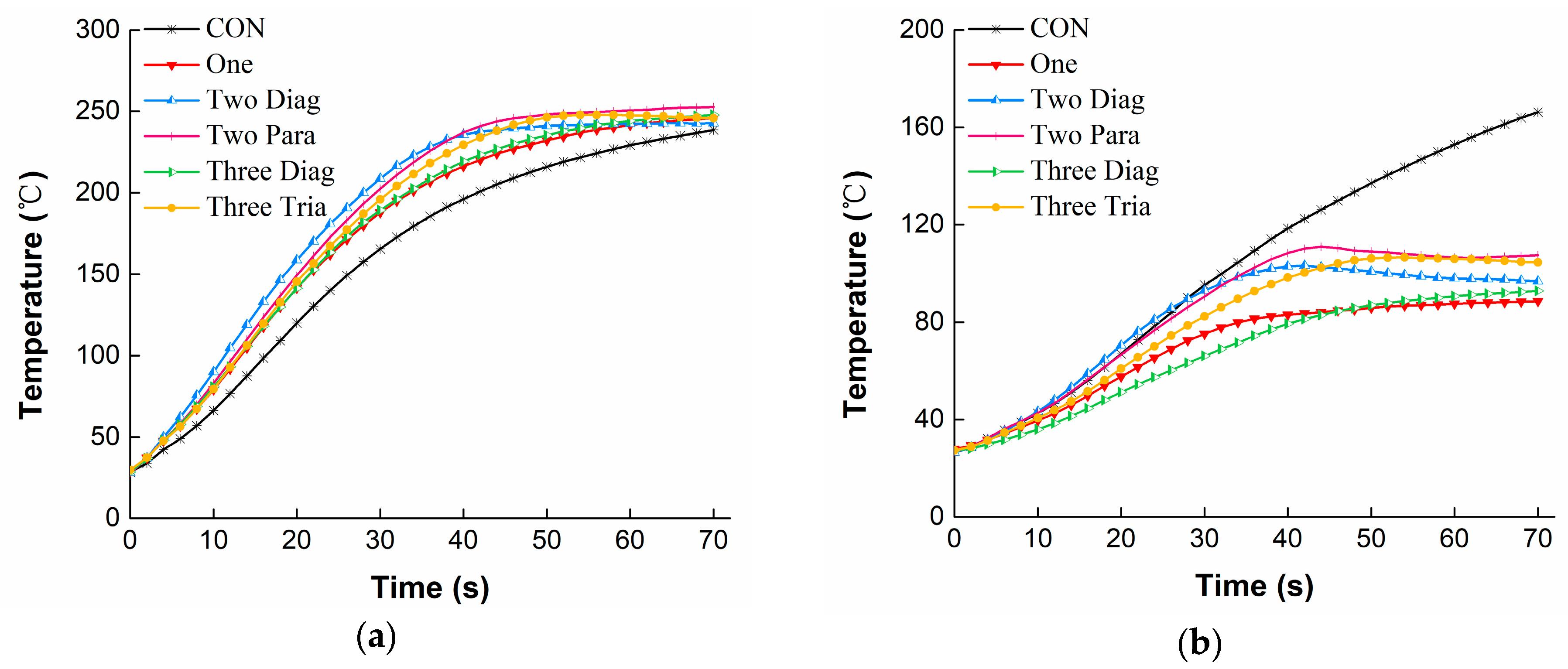


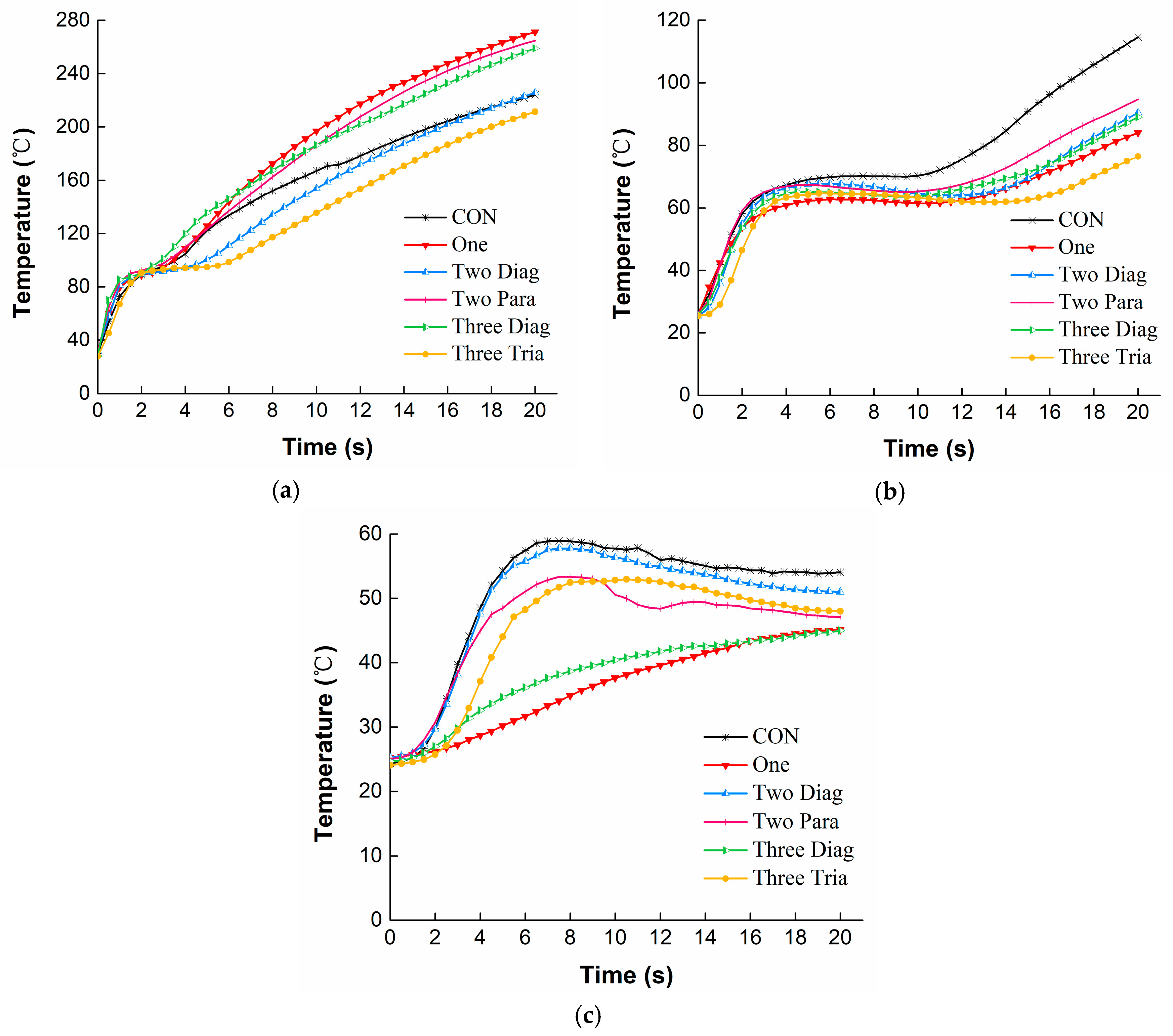
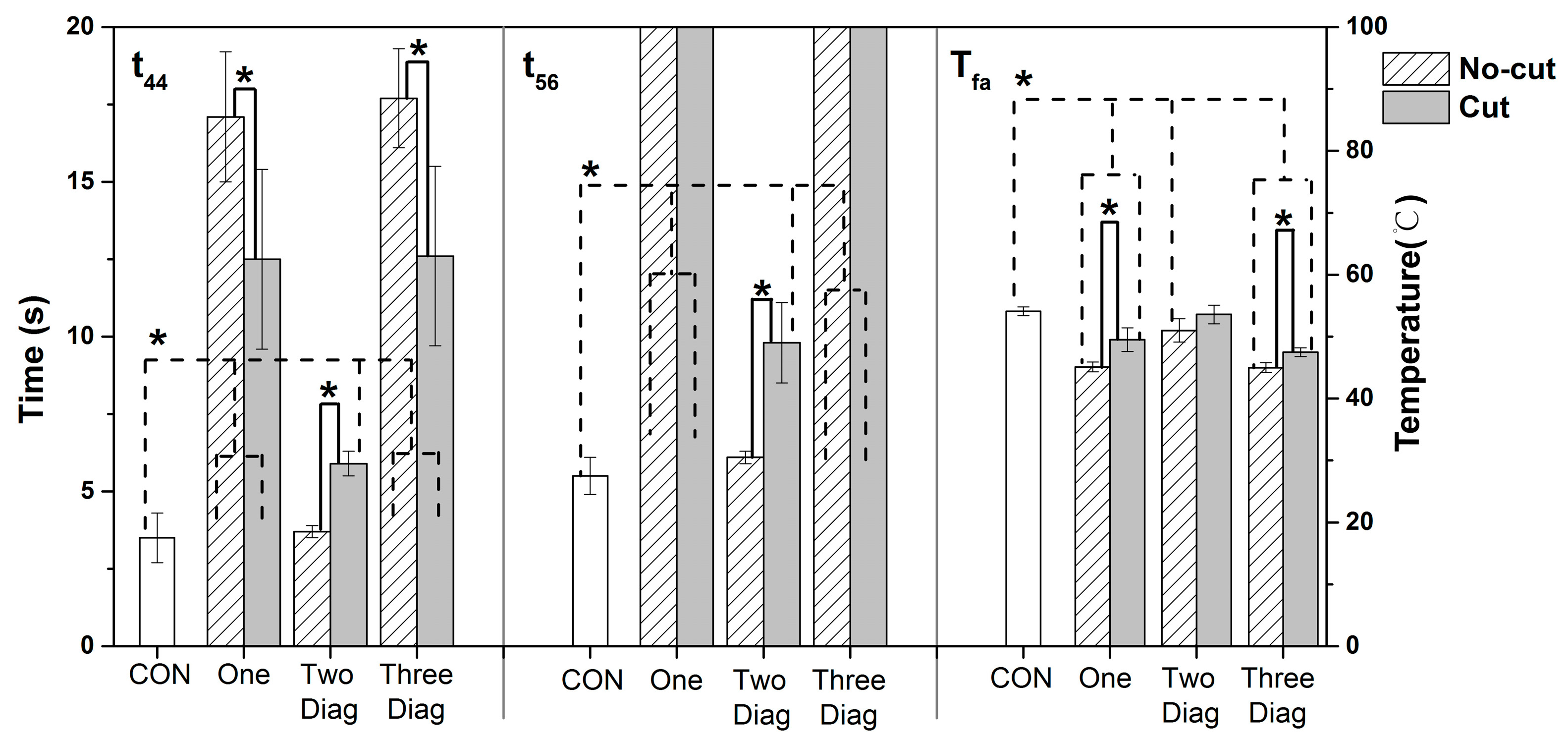


| Layer | Component | Structural Features | Mass (g/m2) | Thickness (mm) |
|---|---|---|---|---|
| Outer shell | 98% meta-aramid/2% para-aramid | Twill | 193.7 | 0.49 |
| Moisture barrier | 100% meta-aramid/PTFE film | Water thorn felt with PTFE | 108.3 | 0.85 |
| Thermal liner | 100% meta-aramid | Needle punched nonwoven with meta-aramid woven face cloth | 200.0 | 0.72 |
| Arrangement | Time to Reach 44 °C | Time to Reach 56 °C | Final Temperature | |||
|---|---|---|---|---|---|---|
| t44 [s] (SD) | The Ratio to CON | t56 [s] (SD) | The Ratio to CON | Tfa [°C] (SD) | The Ratio to CON | |
| CON | 22.7 (1.7) a | 1.00 | 36.4 (5.6) | 1.00 | 97.6 (10.2) | 1.00 |
| One | NR | >3.08 | NR | >1.92 | 42.0 (2.7) b | 0.43 |
| Two Diag | 23.2 (4.4) a | 1.02 | 44.8 (1.0) | 1.23 | 62.5 (6.4) | 0.64 |
| Two Para | 28.4 (4.1) a | 1.25 | 55.0 (5.9) | 1.51 | 60.8 (4.7) | 0.62 |
| Three Diag | 66.2 (6.1) | 2.92 | NR | >1.92 | 44.9 (3.8) b | 0.46 |
| Three Tria | 26.4 (3.5) a | 1.16 | 65.7 (6.4) | 1.81 | 65.6 (3.8) | 0.67 |
| EA | ** | *** | *** | |||
| Arrangement | Time to Reach 44 °C | Time to Reach 56 °C | Final Temperature | |||
|---|---|---|---|---|---|---|
| t44 [s] (SD) | The Ratio to CON | t56 [s] (SD) | The Ratio to CON | Tfa [°C] (SD) | The Ratio to CON | |
| CON | 3.5 (0.8) a | 1.00 | 5.5 (0.6) a | 1.00 | 54.1 (0.7) | 1.00 |
| One | 17.1 (2.1) b | 4.89 | NR | >3.63 | 45.1 (0.8) a | 0.83 |
| Two Diag | 3.7 (0.2) a | 1.06 | 6.1 (0.2) a | 1.11 | 51.0 (1.9) | 0.94 |
| Two Para | 3.9 (1.4) a | 1.11 | NR | >3.63 | 47.1 (1.0) b | 0.87 |
| Three Diag | 17.7 (1.6) b | 5.06 | NR | >3.63 | 45.0 (0.8) a | 0.83 |
| Three Tria | 5.0 (0.3) a | 1.43 | NR | >3.63 | 48.0 (1.3) b | 0.89 |
| EA | *** | NS | *** | |||
| Arrangement | Diagrammatic Presentation | Air Gap Distribution Characters |
|---|---|---|
| One | 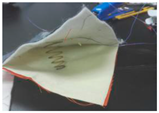 | The center has the biggest air gap (32 mm), and the corner with no fixation has an air gap of approximately 9 mm. |
| Two Diag | 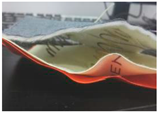 | The location where the spring is inserted has the biggest air gap, but the center has a smaller air gap (27 mm). The corner with no fixation has an air gap of approximately 22 mm. |
| Two Para |  | The location where the spring is inserted shows the biggest air gap, but the center has a smaller air gap (30 mm). The center of the edge that is in line with the two springs has a 26 mm air gap, while the center of the other edge has a 15 mm air gap. |
| Three Diag | 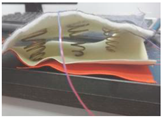 | The air gap located in the line of the springs is becoming uniform. The spring at the center creates the biggest air gap of 32 mm, but the springs closer to the fixed corner create only 14 mm air gap. The corner with no fixation has an air gap of approximately 24 mm. |
| Three Tria |  | The air gap in an equilateral triangle area formed by the springs is becoming uniform. The air gap at the center is about 31 mm, and the air gap at the corner with no fixation is approximately 26 mm. |
© 2018 by the authors. Licensee MDPI, Basel, Switzerland. This article is an open access article distributed under the terms and conditions of the Creative Commons Attribution (CC BY) license (http://creativecommons.org/licenses/by/4.0/).
Share and Cite
He, J.; Lu, Y.; Wang, L.; Ma, N. On the Improvement of Thermal Protection for Temperature-Responsive Protective Clothing Incorporated with Shape Memory Alloy. Materials 2018, 11, 1932. https://doi.org/10.3390/ma11101932
He J, Lu Y, Wang L, Ma N. On the Improvement of Thermal Protection for Temperature-Responsive Protective Clothing Incorporated with Shape Memory Alloy. Materials. 2018; 11(10):1932. https://doi.org/10.3390/ma11101932
Chicago/Turabian StyleHe, Jiazhen, Yehu Lu, Lijun Wang, and Nini Ma. 2018. "On the Improvement of Thermal Protection for Temperature-Responsive Protective Clothing Incorporated with Shape Memory Alloy" Materials 11, no. 10: 1932. https://doi.org/10.3390/ma11101932





